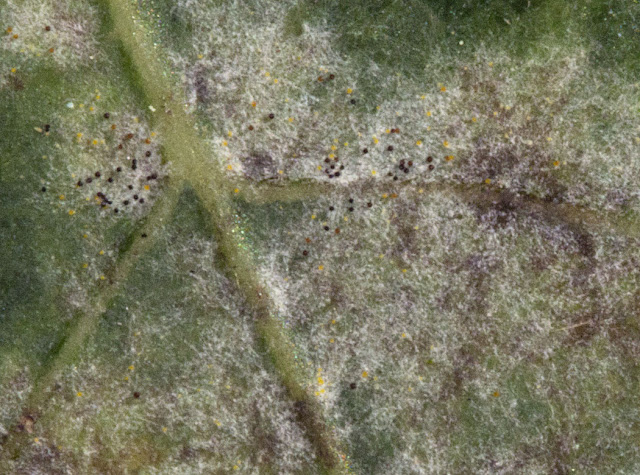 |
| Motorbike racing. Farningham Wood, 2 October 2011. |
This was the view from a high spot at the far side of Farningham Wood on 2 October, on the Orpington Field Club's fungus field trip. I showed some of the results of the trip a few days ago.
The bikes were very noisy. At first it was just a murmur, but as we walked on the sound gradually became a foreground roar. I wouldn't have minded getting a bit closer to try for some dramatic photos, but reasonably enough the group headed away from them.
You can see that the soil there is pure sand. We, in the woods, were mostly on Blackheath Gravel, the same beds that my local commons are on (West Wickham Common, Hayes Common, Keston Common, Spring Park - all within walking distance; I feel well placed.) Despite the dry weather, there were quite a few fungi, and although many of them were dried up, old, or nibbled, they still make good photos.
First, the edge of a beefsteak fungus, a common wood-rotting bracket found on dead wood. It grows on my local oaks, but this one was on a chestnut tree. You can see the pores from which the spores fall when they are ripe.
 |
| Beefsteak fungus, Fistulina hepatica, on a chestnut tree. Farningham Wood, 2 October 2011. |
Slugs love to eat fungi, and this one has been comprehensively nibbled.
 |
| Leccinum aurantiacum. Nibbled by slugs in a scalloped pattern. Farningham Wood, 2 October 2011. |
Ths next one is an old specimen and has mildew growing on it. It is also being explored by a beetle.
 |
| Cortinarius species, on Willow. Farningham Wood, 2 October 2011. |
Now, two small and delicate growths. The first one is tiny. That is a fingernail next to it.
 |
| Mycena speirea next to a finger. Farningham Wood, 2 October 2011. |
 |
| Coprinopsis lagopus. Farningham Wood, 2 October 2011. |
A small cup-shaped fungus.
 |
| Peziza species. Farningham Wood, 2 October 2011. |
Not all of the fungi had large fruiting bodies. This next is an oak leaf mildew, and you can just see the tiny black specks which are its equivalent of mushrooms.
 |
| Oak Powdery Mildew, Microsphaera alphitoides (or Erysiphe alphitoides). Fruiting. Farningham Wood, 2 October 2011. |
The last fungus for today is an unidentifed species which was growing on the dead stem of a nettle. The mycologists were quite pleased to find this; apparently the stems supporting the cups are unusual.
 |
| Unidentified fungus on the dead stem of a nettle. Farningham Wood, 2 October 2011. |
The fungi that decompose tree-trunks are responsible for the blocky cracquelure in this example. This is normally all you see until they put out a fruiting body like the beefsteak bracket near the top of this page.
 |
| Decaying wood. Farningham Wood, 2 October 2011. |
Finally, on our way out of the wood we went along a field edge looking for a rare plant that grows locally, the Deptford Pink. We did find several of them by the hedge, but they were well past flowering, and these seed-heads were all that was left.
 |
| Seed heads of Deptford Pink, Dianthus armeria. Farningham Wood, 2 October 2011. |











It is said to be widespread also in N. America, but I never saw a coprinopsis lagopus before. They are lovely, and the name is delightful, though I don't know why the spell it with an -o- instead of a -u-. Lagopus, rabbit-foot, when young and cupropsis, copper-faced (that would be copper oxide, even if spelled copro-, when mature. Copro- has no -n- in the adjectival forms and, besides, means excremental.
ReplyDelete